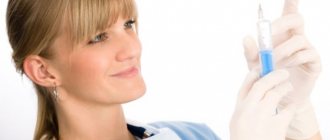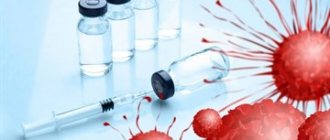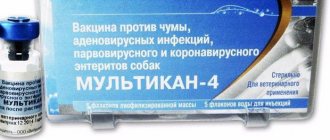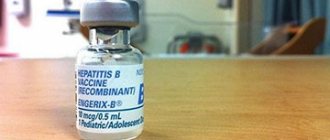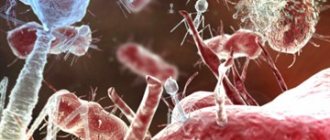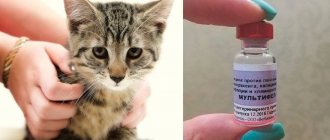Vaccine options
Measles vaccine is often combined with rubella and/or mumps vaccines in countries where these diseases are a problem.
It is equally effective both as a single vaccine and as a combination drug. Combining vaccines against measles and rubella only slightly increases its final cost and makes it possible to combine the costs of vaccine delivery and vaccination. In Russia, the live measles cultural vaccine, the mumps-measles cultural live vaccine (Divaccina), the trivalent vaccine "Priorix" (live), the trivalent vaccine "M-M-R II MMR-II (live)" are used. Measles vaccine is weakly reactogenic. A vaccinated person is not contagious to others. After double immunization, the protective antibody titer is determined in 95-98% of vaccinated people, immunity lasts up to 25 years. The main difference between imported vaccines and domestic ones is the presence of trace concentrations of chicken egg protein, since it is in chicken embryo cell culture that the measles virus is cultivated to make the vaccine. The Russian measles vaccine is prepared by cultivating an attenuated strain of measles virus on a primary cell culture of quail embryos. The domestic vaccine meets WHO requirements and is superior to the Belgian and American ones in terms of a lower percentage of vaccine reactions, absence of rash and temperature rise above 38.50 C.
Live mumps-measles vaccine (Vaccinum parotidi-morbillorum culturarum vivum)
HIV infection is not a contraindication for vaccination. For mild forms of ARVI and acute intestinal diseases, vaccination is carried out immediately after body temperature normalizes. Vaccination is not recommended during periods of increased incidence of serous meningitis. Vaccination is carried out no earlier than 3-6 months after the end of immunosuppressive therapy. Vaccination can be carried out simultaneously (on the same day) with other calendar vaccinations (against polio, hepatitis B, whooping cough, diphtheria, tetanus) or no earlier than 1 month after the previous vaccination; after the introduction of human Ig - no earlier than 2 months, and after vaccination with the mumps-measles vaccine, the introduction of Ig is allowed only after 2 weeks. If it is necessary to administer Ig earlier than this period, vaccination against mumps and measles should be repeated. Persons temporarily exempt from vaccination should be monitored and vaccinated after contraindications are lifted. A history of febrile convulsions, as well as hyperthermia above 38.5 degrees C in the post-vaccination period are an indication for the prescription of antipyretic drugs. Immediately before administration, the vaccine is diluted with a solvent for measles, mumps and mumps-measles cultured live dry vaccines at the rate of 0.5 ml of solvent per 1 vaccination dose of the vaccine. The vaccine should completely dissolve within 3 minutes. The vaccine or solvent in ampoules with damaged integrity, labeling, changes in their physical properties (color and transparency, etc.), expired or improperly stored are not suitable for use. The opening of ampoules and the vaccination procedure are carried out in strict compliance with the rules of asepsis and antiseptics. Ampoules with vaccine and solvent at the incision site are treated at 70 degrees. ethanol and break off, while preventing ethanol from entering the ampoule. To dilute the vaccine, select the entire required volume of solvent and transfer it to an ampoule with dry vaccine. After mixing, the vaccine is drawn into a sterile syringe with another needle and used for vaccination. The dissolved vaccine is used immediately and cannot be stored. The vaccination performed is registered in the established registration forms, indicating the name of the drug, date of vaccination, dose, manufacturer, batch number, date of manufacture, expiration date, reaction to the vaccine.
Principles and purposes of vaccination
Vaccination against measles has the following positive properties - it prevents epidemics of infection, reduces mortality and disability, and also helps limit the circulation of the virus in the population. Because measles is one of the leading causes of death among young children, the main goal of measles vaccination is to prevent the spread of this disease throughout the world.
By the end of 2014, 85% of the world's children under two years of age had received one dose of measles vaccine, and 148 countries included a second dose as part of their routine immunization programs. Immunization against measles is recommended for all susceptible children and adults for whom it is not contraindicated. This vaccine should be used to prevent outbreaks; large-scale vaccination to control existing outbreaks has limited effect.
The difference between the new vaccine
In 2021, two vaccines against coronavirus infection were registered in Russia. In August, the drug “Sputnik V” (“Gam-Covid-Vac”), created by the N. F. Gamaleya Center of the Russian Ministry of Health, was registered, and in October, “EpiVacCorona”, a drug from Novosibirsk. Both vaccines reliably protect against new coronavirus infection, but their mechanism of action is different.
Let us remember that when creating the Sputnik V , the genetic basis of adenovirus particles was removed, and instead a gene with the code for a special protein (the “spike” of the coronavirus) was introduced. This protein does not pose any danger to humans. It helps the immune system to respond correctly to the virus and produce antibodies to it (immunoglobulins), which will further protect against infection.
And the EpiVacCorona contains three artificially synthesized peptides (small proteins) of the coronavirus, as well as carrier proteins and excipients that are needed for the penetration of vaccine components into the body. These peptides are recognized by the immune cells of the vaccinated person, and antibodies are produced to them. If, after vaccination, a person encounters the “real” coronavirus, his immune system “recognizes the enemy by his peptides” and repels the attack.
The third, new drug “CoviVac” is an inactivated whole-virion vaccine against coronavirus, developed in Russia by the Chumakov Center. The Ministry of Health registered it in February 2021. Such drugs use either artificially weakened viruses that are not capable of causing disease, or those that have already been killed. This was stated by the head of the commercial department of the Federal Scientific Center for Research and Development of Immunobiological Preparations named after. M. P. Chumakova RAS Ekaterina Korduban .
“Our vaccine is inactivated, created using classical technology, so it has a proven safety profile. This is one of the safest approaches to vaccination, to immunization,” she explained.
In addition, CoviVac is unpretentious; the conditions for its storage and transportation do not require anything special.
Virologist Doctor of Biological Sciences Alexey Agranovsky spoke positively about the drug and said that the new vaccine is the most “predictable.”
“I would expect the least pitfalls from a classic vaccine that uses the inactive SARS-CoV-2 virus,” he said.
The specialist also clarified what properties “CoviVac” differs from its predecessors.
“If Sputnik V is a vector drug that is based on adenoviruses, the spike protein of which causes an immune response, then CoviVac is a whole-virion vaccine,” added Alexey Agranovsky.
According to the virologist, the drug was created using classical technology - most vaccines until the 2000s were created using it.
Chairman of the St. Petersburg Health Committee Dmitry Lisovets, during a press conference at TASS, which was held online, spoke about the features of the CoviVac vaccine.
“The only difference is that the current vaccines can be used for people aged 65+, the new vaccine [CoviVac] is used for residents under the age of 65. I recommend using those vaccines that are now available, and not waiting for new ones,” explained the head of the St. Petersburg Health Department.
Vaccine effectiveness
In 2014, about 85% of all children worldwide received one dose of measles vaccine within the first year of life (up from 73% in 2000). Accelerated immunization efforts have had a significant impact on reducing measles deaths. In 2000-2014 Measles vaccination prevented an estimated 17.1 million deaths. Global measles deaths have dropped by 75%, making the disease's vaccine one of the most beneficial public health advances.
Vaccination also effectively prevents the risk of dangerous complications. For example, a complication such as encephalitis occurs in 1 case out of a thousand sick people and 1 case out of 100,000 vaccinated people. The risk of developing a serious complication in the case of measles vaccination is 100 times less than with a full-fledged disease. The measles vaccination provides a person with immunity for a fairly long period of time - on average 20-25 years.
Today, research has revealed active immunity against measles in people vaccinated up to 36 years ago. Why give a booster vaccination against measles to a 6-year-old child, when only 5 years have passed since the first vaccination?
This need is due to the fact that approximately 15% of those vaccinated do not develop immunity 1 year after the first dose, and children remain unprotected. Therefore, the second vaccination is aimed at ensuring that children who have not developed immunity at all (or have a weakened one) can receive reliable protection against infection before starting school.
Post-vaccination reactions
All measles vaccines contain live, weakened (attenuated) measles viruses. Measles vaccine is weakly reactogenic. Vaccination against measles, as a rule, is not accompanied by any clinical manifestations. Most children do not experience any post-vaccination reactions. Among the undesirable post-vaccination events, an increase in body temperature (usually no higher than 37-380 C) and mild malaise for 2-3 days may be noted. In children prone to allergic reactions, a measles-like rash may appear (from 4 to 15 days after vaccination). Serious complications are extremely rare.
Risk of post-vaccination complications
In extremely rare cases, neurological disorders develop. Complications in the form of encephalopathy - less than 1 case per 300 thousand vaccinated people, convulsions - <0.0001%. Encephalitis has been reported at an incidence of less than 1 case per 10 million doses, which is significantly lower than that observed in natural diseases (measles: 1:1000 -1:2000; rubella: 1:6000 cases).
Thrombocytopenia – 1 case per 40,000 vaccinated people. This is why, as a rule, monitoring of blood tests (platelet levels) in children is required before immunization against measles.
Contraindications
Hypersensitivity (systemic allergic reaction, for example, anaphylactic shock, angioedema - Quincke's edema), including to aminoglycosides, chicken or quail egg white, severe reaction or complications to the previous dose, primary and secondary immunodeficiency conditions, malignant blood diseases, neoplasms , pregnancy.
Notes:
- A history of contact dermatitis caused by an aminoglycoside antibiotic (neomycin) and a non-anaphylactic allergic reaction to chicken (quail) eggs are not a contraindication to vaccination!
- The drug can be administered to persons with asymptomatic HIV infection, as well as to patients with AIDS!
- Vaccination is postponed until the end of acute manifestations of the disease and exacerbation of chronic diseases. For mild ARVI, acute intestinal diseases, etc., vaccinations can be carried out immediately after the temperature has normalized!
Live mumps-measles vaccine
HIV infection is not a contraindication for vaccination.
For mild forms of ARVI and acute intestinal diseases, vaccination is carried out immediately after body temperature normalizes.
Vaccination is not recommended during periods of increased incidence of serous meningitis.
Vaccination is carried out no earlier than 3-6 months after the end of immunosuppressive therapy.
Vaccination can be carried out simultaneously (on the same day) with other calendar vaccinations (against polio, hepatitis B, whooping cough, diphtheria, tetanus) or no earlier than 1 month after the previous vaccination; after the introduction of human Ig - no earlier than 2 months, and after vaccination with the mumps-measles vaccine, the introduction of Ig is allowed only after 2 weeks. If it is necessary to administer Ig earlier than this period, vaccination against mumps and measles should be repeated.
Persons temporarily exempt from vaccination should be monitored and vaccinated after contraindications are lifted.
A history of febrile convulsions, as well as hyperthermia above 38.5 degrees C in the post-vaccination period are an indication for the prescription of antipyretic drugs.
Immediately before administration, the vaccine is diluted with a solvent for measles, mumps and mumps-measles cultured live dry vaccines at the rate of 0.5 ml of solvent per 1 vaccination dose of the vaccine. The vaccine should completely dissolve within 3 minutes.
The vaccine or solvent in ampoules with damaged integrity, labeling, changes in their physical properties (color and transparency, etc.), expired or improperly stored are not suitable for use.
The opening of ampoules and the vaccination procedure are carried out in strict compliance with the rules of asepsis and antiseptics.
Ampoules with vaccine and solvent at the incision site are treated at 70 degrees. ethanol and break off, while preventing ethanol from entering the ampoule.
To dilute the vaccine, select the entire required volume of solvent and transfer it to an ampoule with dry vaccine. After mixing, the vaccine is drawn into a sterile syringe with another needle and used for vaccination.
The dissolved vaccine is used immediately and cannot be stored.
The vaccination performed is registered in the established registration forms, indicating the name of the drug, date of vaccination, dose, manufacturer, batch number, date of manufacture, expiration date, reaction to the vaccine.

